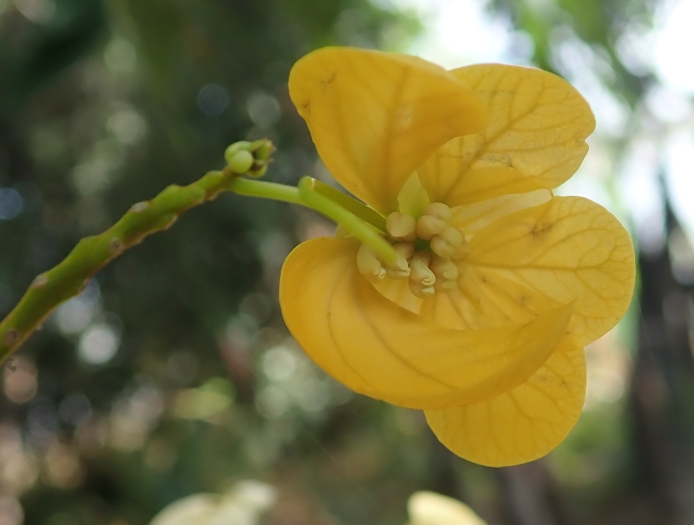Spectacular Cassia
(Senna spectabilis)
Spectacular Cassia (Senna spectabilis)
/
/

Robert Taylor
CC BY 4.0
Image By:
Robert Taylor
Recorded By:
Copyright:
CC BY 4.0
Copyright Notice:
Photo by: Robert Taylor | License Type: CC BY 4.0 | License URL: http://creativecommons.org/licenses/by/4.0/ | Rights Holder: Robert Taylor | Publisher: iNaturalist | Date Created: 2020-06-04T11:26:48-07:00 |











































Estimated Native Range
Summary
Senna spectabilis, commonly known as Spectacular Cassia, is an evergreen tree native to tropical regions of South and Central America, where it thrives in a variety of habitats including forest edges, clearings, and disturbed areas. It can grow to a height and width of 15–20 feet with a rounded vase-shaped crown that is dense and symmetrical. The tree features multiple trunks with smooth grey bark marked by horizontal lines, which become warty and display broad vertical bands of lenticels as the tree matures. The stem is finely hairy in the first year. The leaves, which are 2–4 inches long, exhibit nyctinasty, closing at night and opening at dawn. Spectacular Cassia is known for its bright yellow inflorescences, 10–50 cm long, with a corolla 3.5–4 cm in diameter and five unequal petals. The flowers are very showy and bloom during the summer months, followed by elongated pod-shaped fruits, 6–12 inches in length, that are dry, dehiscent, and black/brownish, containing numerous flat brown seeds.
Spectacular Cassia is valued for its rapid growth, showy flowers, and adaptability to a range of soil types, including moist, clay, sand, loam, slightly alkaline, and acidic soils, even in poor black cotton soils. It is often used as an ornamental in front yards, parks, gardens, and around buildings. The plant requires full sunlight and well-drained soil to thrive. While there are no known diseases that significantly affect this species, it is potentially invasive outside its native range, and gardeners should check local regulations before planting.CC BY-SA 4.0
Spectacular Cassia is valued for its rapid growth, showy flowers, and adaptability to a range of soil types, including moist, clay, sand, loam, slightly alkaline, and acidic soils, even in poor black cotton soils. It is often used as an ornamental in front yards, parks, gardens, and around buildings. The plant requires full sunlight and well-drained soil to thrive. While there are no known diseases that significantly affect this species, it is potentially invasive outside its native range, and gardeners should check local regulations before planting.CC BY-SA 4.0
Plant Description
- Plant Type: Tree
- Height: 15-20 feet
- Width: 10-15 feet
- Growth Rate: Rapid
- Flower Color: Yellow
- Flowering Season: Spring, Summer, Fall
- Leaf Retention: Evergreen
Growth Requirements
- Sun: Full Sun
- Water: Low, Medium
- Drainage: Medium
Common Uses
Bee Garden, Bird Garden, Butterfly Garden, Fragrant, Low Maintenance, Showy Flowers
Natural Habitat
Native to tropical regions of South and Central America, including forest edges, clearings, and disturbed areas
Other Names
Common Names: Casia Amarilla, Golden Shower, Whitebark Senna, Kaha-Kona, Munjal-Kona, Bruscon, Canafistola Macho, Canchin, Candelilla, Candelillo
Scientific Names: , Senna spectabilis, Cassia spectabilis, Pseudocassia spectabilis, Cassia trinitatis, Cathartocarpus humboldtianus,
GBIF Accepted Name: Senna spectabilis (DC.) H.S.Irwin & Barneby